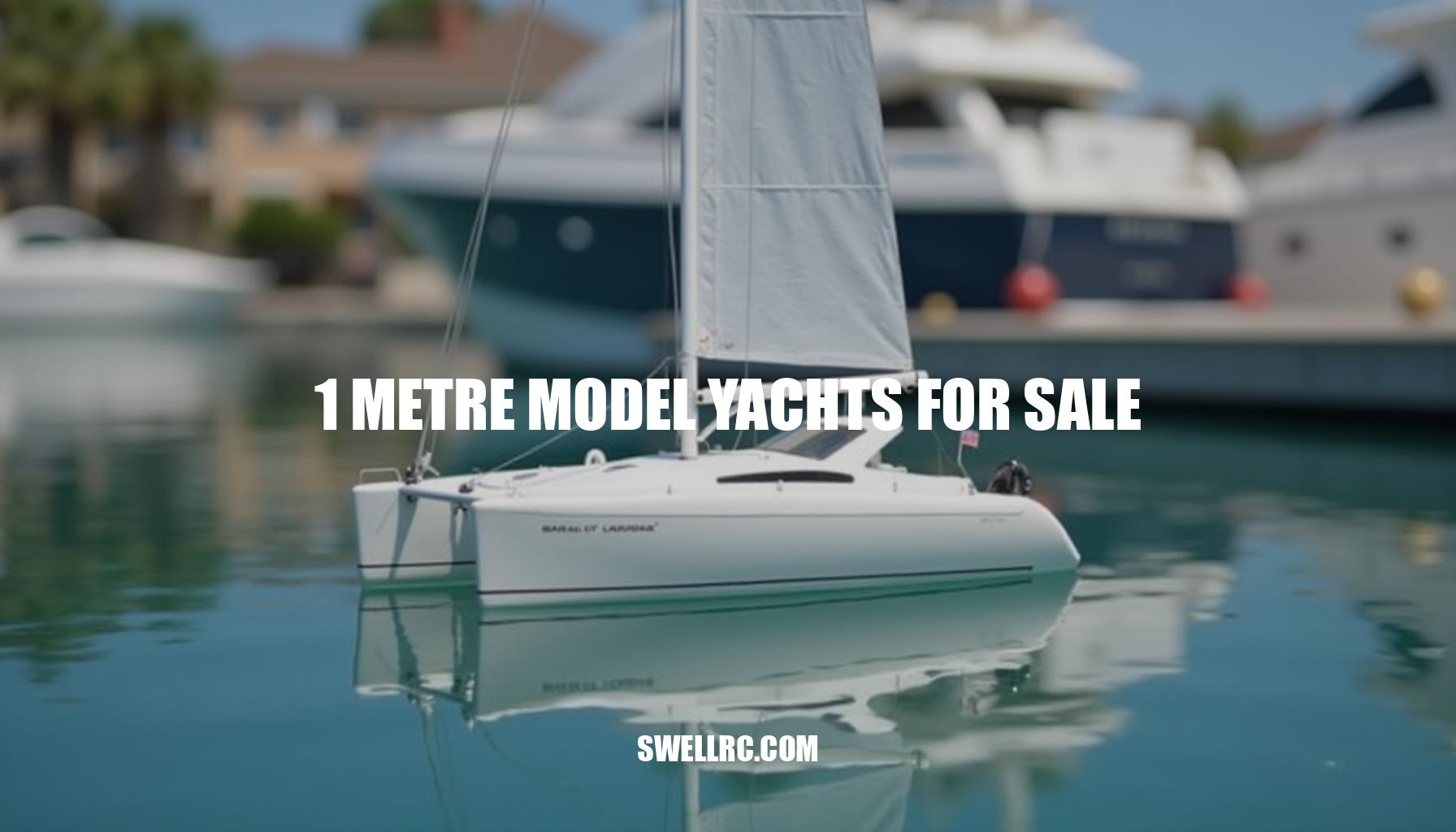1 Metre Model Yachts for Sale: Expert Tips and Insights
The first time I sheeted in a 1 metre model yacht and felt the hull leap forward, it hooked me. There’s a particular thrill in balancing wind, water, and tiny adjustments that turn plastic and carbon into poetry. These are RC sailboats with real presence—precision machines that fit in a hatchback yet carve upwind like their full-size cousins.
A 1 metre model yacht is exactly what it sounds like: roughly 1000 mm in length, big enough for serious performance and small enough to be approachable. They’re ideal for beginners who want stability and for seasoned racers who obsess over rigs, foils, and sail shape. If you’re curious about proven one-design options, the classic Soling 1 Meter class is a great launch point.
In this guide to the best RC sailboats, I’ll share what I’ve learned about choosing the right boat, understanding performance, picking worthwhile upgrades, and keeping your yacht race-ready for seasons to come. Whether you’re diving into model yacht racing or simply want to explore remote control boats crafted for skill and enjoyment, these 1 metre model yachts for sale offer a perfect blend of accessibility and competitive edge in the radio-controlled sailing world.
Why the 1 metre class is a global favorite
The 1 metre class model yachts perfectly balance size and performance, offering a substantial sail area that delivers punchy acceleration while maintaining a hull length that cuts straight through choppy waters. This makes them highly appealing within the RC sailing community, particularly due to their approachable costs which enhance accessibility for newcomers. Most 1 m designs feature interchangeable rig sets—commonly labeled A, B, and C—to allow precise rig tuning based on varying wind strength, fostering fair and tactical racing rather than costly arms races.
| Specification | Range/Value |
|---|---|
| Length | Approximately 1000 mm |
| Sail Area | 0.5–0.6 m² (depending on class rules) |
| Displacement | 3.5–6.0 kg |
| Radio Gear | Standard, reliable servos and receivers |
The 1 metre format is also highly portable and convenient; with just one rig bag, hull, and stand, you’re ready to sail at the lake or any local water body. For those curious about how the 1 metre class compares within the broader sailing landscape, it holds a unique spot between the ultra-portable Footy class sailboat—known for rewarding ingenuity in tiny packages—and the impressive presence and glide of large RC sailboats.
- Footy class sailboats emphasize creativity and compactness, making them fantastic for beginners or those seeking ultra-portable fun.
- 1 metre class boats hit the Goldilocks zone, where skillful rig tuning and strategic sailing truly shine under fair class rules.
- Large RC sailboats offer a fuller presence on the water and graceful glide, often demanding more space and investment.
Additionally, classes like the Soling 1M differentiate themselves not just by size but their one-design emphasis, prioritizing equal equipment and closely contested races—a philosophy that highlights the sport’s tactical nature rather than financial advantage. Overall, the 1 metre class remains a favorite in the model yacht racing community for delivering an engaging blend of accessibility, competitive fairness, and thrilling sailing performance.
Size and class comparison at a glance
When considering an RC boat size comparison, it’s essential to understand the differences in dimensions, sail areas, costs, and performance characteristics among popular model yacht classes. Here’s an overview:
| Class | Typical Length | Typical Sail Area | Typical Cost | Learning Curve | Speed Feel | Key Appeal |
|---|---|---|---|---|---|---|
| 1 Metre | ~1000 mm | ~0.5–0.6 m² | Mid-range ($400–$1500+ depending on kit vs. race build) | Moderate | Fast and tactical | Best balance of performance and portability |
| Footy | ~300 mm | ~0.05–0.08 m² | Low to mid ($80–$300) | Easy to moderate | Lively in puffs but limited waterline | Ultra-portable, quick builds, fun design experimentation |
| Larger RC Sailboats | 1200–2000+ mm | 0.7–1.5 m²+ | Higher ($1000–$3000+) | Moderate to advanced | Majestic glide, high momentum | Scale presence and open-water authority |
For the beginner RC sailboat enthusiast, Footy class is often recommended due to its affordability and straightforward learning curve, making it a popular choice in the Footy vs 1 metre debate. While Footys offer a lively sailing experience and exceptional portability, 1 Metre class boats provide a noticeable boost in both speed and tactical depth, contributing to their popularity among racers seeking a balance between performance and ease of transport.
On the other end, investing in large RC sailboats cost involves a higher price point but rewards sailors with impressive model yacht speed and the majestic presence of a full-scale sailboat on the water. Their higher momentum and scale authenticity make them ideal for enthusiasts wanting a commanding sailboat experience.
Ultimately, understanding the cost of RC sailboat options alongside size and sailing characteristics will help you select a model that fits your skill level, budget, and sailing ambitions.
Buying the right 1 metre model yacht and brand
When helping friends choose their first 1 metre model yacht, we always begin by clarifying their goals. Are they looking for casual laps around the pond or eager to dive into club racing? Knowing whether you’re a tinkerer who enjoys customizing or a buy-it-and-sail type shapes the ideal choice.
Legacy model yacht brands like Graupner model boats have long influenced the scene with their well-engineered hulls and hardware, providing reliable performance and quality – explore their range here. Another respected name, Robbe RC yachts, is invaluable for those hunting classic kits and quality secondhand finds; their offerings can be browsed here.
When comparing fiberglass vs ABS hull materials, consider that fiberglass (or Fiber Reinforced Plastic – FRP) offers superior durability and often better performance, while ABS provides a more budget-friendly option without compromising too much on strength. Wooden hulls remain a favorite for classic builds, appreciated for their aesthetic but requiring more upkeep.
Understanding how 1 metre sailboats differ from larger, sometimes motorized platforms can also help sharpen buying priorities. Exploring larger-scale RC boats here can give perspective on handling and maintenance demands.
Key factors to assess include:
- Hull material: durability versus cost—fiberglass/FRP, ABS, or wood
- Keel and rudder stiffness: essential for responsive control
- Mast and boom options: adaptability and ease of repairs
- Sail quality: critical for performance, especially in club racing
- Servo torque and reliability: to handle variable wind conditions
- Waterproofing of hatches: for durability and electronics protection
- Spare parts availability: through a responsive seller or active club network
For racers, access to class-legal sails and rigs is pivotal, ensuring fair competition and upgrade options. Casual sailors may prioritize a stable hull and straightforward rigging to maximize enjoyment with minimal fuss. Knowing where to buy 1 metre model yachts with solid aftersales support can save time and headaches down the line.
Whether you are budgeting for your first boat or seeking to upgrade to a well-known model yacht brand, factoring in these considerations will help you make an informed purchase that matches your sailing aspirations.
Who should buy what: a simple 1 m buyer’s guide
Choosing the best RC sailboats for competitive sailing depends largely on your experience level, what features you prioritize, and your model yacht budget. Whether you’re a beginner seeking a stable and easy-to-handle vessel or a seasoned racer needing precision tuning, understanding the different options is essential.
| Sailor type | What to prioritize | Budget range | Example features |
|---|---|---|---|
| Beginner | Stability, simple rigging, durable hull | $300–$700 | ABS or FRP hull, single high-torque winch servo, easy-access radio bay, pre-sewn sails |
| Intermediate | Upgrade path, better sails, multiple rig sets | $600–$1200 | Stiffer fin and rudder, aluminum or carbon spars (as class rules allow), quality sail cloth, waterproof radio tray |
| Competitive racer | Class compliance, tuning range, precision foils | $1000–$2000+ | Faired foils, matched A/B/C rigs, low-friction sheeting, fine-adjust backstay and vang, proven race hull design with active fleet support |
When selecting RC sailboat kits, beginners should consider models marketed as beginner RC yachts that emphasize stability and durability. Intermediate sailors looking to progress can benefit from better sails and multiple rig sets to fine-tune performance, while competitive racers need boats with an extensive tuning range and racing sails designed specifically for speed and maneuverability.
Accessories and upgrades that transform performance
My biggest leap in performance came from servo tuning that ensures clean, reliable control and sails crafted from premium sail materials offering crisp responsiveness. Start with a trustworthy winch servo and rudder servo—command precision and repeatability are everything in radio-controlled sailboats. Then focus on reducing friction through low-friction sheeting, smooth fairleads, and a precise vang, paired with sails that maintain shape even across gusts.
Don’t overlook hull modifications such as true keel alignment, rudder centering, and fair foils; these seemingly minor changes pay off upwind like magic.
If you enjoy building and tinkering, I highly recommend exploring radio-controlled sailboat kits that invite customization from day one, allowing for continuous performance upgrades.
For context on speed handling—and understanding why sail tuning matters more than raw velocity—consider the 45 RC boat speed comparison between a nimble yacht and a purpose-built speedster like this 45-inch Cigarette-style RC boat. This comparison highlights the distinct dynamics of sail versus power models and emphasizes the finesse required in sailboat tuning.
Lastly, if your modeling hobby straddles both sail and power, you might enjoy browsing scale propulsion gear such as model outboard motors. These are ideal for powerboats and scale builds, though not typically used on sail yachts.
Check out the selection here: model outboard motors for model boats.
| Component | Upgrade Focus | Benefit |
|---|---|---|
| Servos | Precise tuning of winch and rudder servos | Reliable control and repeatability |
| Sails | High-quality sail materials & maintaining shape | Responsive sail trim across conditions |
| Hull | Keel alignment, rudder centering, fair foils | Improved upwind performance and balance |
| Sheeting and Fairleads | Low-friction components and smooth angles | Efficient sail adjustment and less wear |
Top 5 performance upgrades I’d buy again
When aiming for optimal performance in RC sailboat tuning, consider a comprehensive approach incorporating several key sail upgrades. Begin with quality sails tailored to your rig set featuring a crisp draft and reinforced corners for enhanced durability and performance. Integrate a high-torque, reliable winch servo that offers a smooth spool and operates at the proper voltage to maintain consistent control.
Use low-stretch sheets in combination with polished fairleads to establish low-friction rigging which significantly reduces wear and improves responsiveness. Ensure your fin and rudder are designed as true, faired foils with perfect alignment to minimize drag and maximize efficiency. Finally, outfitting your rigging hardware with micro-adjustment capabilities such as a backstay tensioner, adjustable vang, and shroud adjusters enables precise backstay adjustment for fine-tuning your sailboat’s balance and trim.
Ownership: maintenance, storage, and racing rhythm
Owning a 1 metre model yacht blends the precision of maintaining RC sailboats with the dedication of a personal ritual. After each sail, I meticulously rinse lake water off all hardware and carefully inspect the sheet paths to ensure smooth operation. I also dab any moisture from the radio bay waterproofing to prevent water ingress and loosen rig tension before safe storage.
When it comes to model yacht transport, I rely on a padded hull cradle and a rig bag that prevent dings and preserve the sail’s shape, essential for preserving performance.
For racing preparation, keeping a detailed log of mast rake, bend, and sheet mark positions allows me to quickly replicate optimal settings if conditions repeat—making me instantly fast on the water.
The welcoming sailing communities and local clubs offer scheduled sails, while regional regattas provide a crash course in skill and knowledge, often more valuable than a month of solo practice. Throughout my upkeep routine, I prioritize key areas:
- Water ingress prevention: A clean, well-sealed hatch with a properly lubricated O-ring and quality tape is crucial to save electronics from damage.
- Battery management: Checking voltage under load ensures reliable power during races and prevents sudden failures.
- Ballast trim: Fine-tuning weight placement with small ballast adjustments achieves a neutral helm, improving handling and responsiveness.
By blending these practices, I maintain my model yacht in top condition, ready for both leisurely sails and competitive racing.
Pre-race tuning checklist (what I actually use)
When preparing your 1 metre model yacht for optimal performance, understanding how to tune 1 metre model yacht sails is critical. Start your pre-race checklist by ensuring the keel and rudder are secure, aligned, and have no play. Check the sheets to confirm they are free-running, free of chafe, and offer the proper throw on full sheet-in, allowing smooth sail adjustments.
Rig tuning is essential; set shroud tension correctly, tune the backstay according to the breeze conditions, and adjust the vang to provide sufficient leech control. Position telltales so they are clearly visible and indicate the sail draft, ideally slightly forward upwind in lighter air. Performing a range check on your radio system confirms sufficient control distance, while verifying the failsafe settings ensures your yacht’s safety in case of signal loss.
Aim for a neutral helm with the boat floating on its design waterline when sailing close-hauled, achieving balanced and responsive handling. Lastly, pack essential spares like tape, extra sheets, fresh batteries, a small toolkit, and a dry cloth to address any issues swiftly on race day.
Troubleshooting: quick fixes for common problems
If you’re facing common issues during your model yacht sailing sessions, effective model yacht troubleshooting can make all the difference. For instance, water ingress often occurs around the hatch lip—cleaning this area thoroughly, replacing or re-seating the gasket, and applying a thin perimeter tape before launching can prevent leaks. When dealing with weather helm upwind, consider moving the mast rake forward slightly or shifting some weight forward; additionally, sail trimming by flattening the main sail with more backstay tension and vang adjustment helps maintain helm balance.
Experiencing sluggish tacks?
It’s essential to check rudder centering, increase rudder throw carefully, and ensure the sheets release smoothly during turns for better responsiveness. For downwind control and to reduce porpoising, ease the vang a little to open the leech and move the draft forward while keeping your weight low and centralized. Lastly, if your model yacht suffers from radio interference issues, re-seat connectors, separate the antenna from power leads, and test with a fresh battery under load to ensure consistent communication.
Conclusion: why we keep coming back to the lake
Sailing a 1 metre yacht perfectly balances performance and quality with a sense of play. The 1 metre model yachts for sale offer not just real speed and deep tuning options but also entry into a vibrant community racing scene where enthusiasts eagerly share rig notes in the parking lot. When you’re on the hunt for your next model, chase three essentials: a hull with proven manners, sails that hold their shape, and a reputable seller who backs you up with parts and advice.
Quality stands out quickly once you’ve trimmed a good rig and felt the boat respond to a header. For those driven by model yacht passion, the intricacies of RC sailing craftsmanship offer endless inspiration. Browsing performance-focused sellers can ignite your imagination and elevate your sailing experience.
Explore options and ignite your RC sailing inspiration by checking out thoughtfully crafted boats here: https://www.swellrc.com/bonzi-boats-for-sale/
See you on the water—test, tune, learn, and enjoy every tack with your new 1 metre yacht!
Frequently Asked Questions
- What makes 1 metre model yachts popular among RC sailors?
They hit the best balance of performance, portability, and cost. A 1 m hull has enough waterline and sail area to feel fast and tactical, yet it’s easy to transport and set up. Strong club scenes, standardized rigs, and proven designs make great racing without needing exotic materials or huge budgets. - How fast can a 1 metre RC yacht go?
In moderate breeze on an A rig, expect roughly 4–7 knots (about 5–8 mph). In strong gusts and on downwind surf, brief peaks can push higher. The sensation of speed is amplified by the boat’s size and responsiveness, so good trim often matters more than raw top speed. - What are the best brands for 1 metre yachts?
Look for brands and builders with active class support, quality foils, and durable rigs. Legacy names like Graupner and Robbe are well-regarded, and many competitive racers also choose specialized IOM builders and sailmakers known within local clubs. The best brand is the one with readily available parts and a supportive fleet near you. - Are RC sailboat kits better than pre-built models?
Kits are great if you enjoy building and want to customize from day one; they teach you the boat inside-out. Pre-built models get you on the water faster with fewer tools and often less risk of build errors. Performance potential can be excellent either way—choose based on time, tools, and how much you enjoy the build process. - How do I maintain and transport a 1 metre model yacht?
Rinse hardware after sailing, dry the radio bay, and loosen rig tension before storage. Use a padded cradle and rig bag for transport, tape the hatch before launching, and store batteries charged within manufacturer guidelines. Regularly check for play in the fin and rudder, and keep a small toolkit and spares with the boat. - Where can I find 1 metre model yachts for sale online?
Start with RC sailing specialty shops, class association forums, and reputable brand dealers. Club communities often share for-sale posts, and regional regattas are good places to network. Prioritize sellers that offer spare parts, rig options, and helpful setup guidance.



